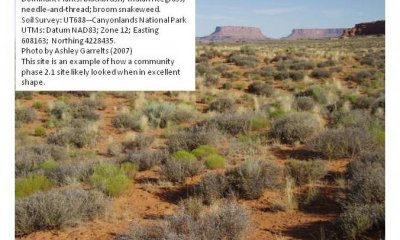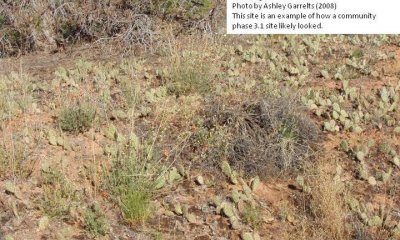
Semidesert Sand (Blackbrush)
Scenario model
Current ecosystem state
Select a state
Management practices/drivers
Select a transition or restoration pathway
- Transition T1A More details
- Transition T2A More details
- Transition T2B More details
-
No transition or restoration pathway between the selected states has been described
Target ecosystem state
Select a state
Description
The reference state represents the plant community and ecological dynamics of the Semidesert Sand, blackbrush site. This state includes the biotic communities that become established on the ecological site if all successional sequences are completed under the natural disturbance regimes. The reference state is generally dominated by blackbrush, however depending on disturbance history, native grasses, forbs, or other shrubs may occupy significant composition in the plant community. Primary disturbance mechanisms include climate fluctuations and both native and domestic herbivore grazing. Timing of these disturbances dictates the ecological dynamics that occur. The reference state is self sustaining and resistant to change due to high resistance to natural disturbances and high resilience following natural disturbances. Once invasive plants establish, return to the reference state may not be possible.
Reference State: Plant community resistant to fluctuations in climate.
Indicators: A community dominated by blackbrush where native perennial grasses and forbs may or may not be present.
Feedbacks: Natural fluctuations in climate that allow for a self sustaining blackbrush and native grass community. Any disturbance that may allow for the establishment of invasive species.
At-risk Community Phase: All communities are at risk when native plants are stressed and nutrients become available for invasive plants to establish.
Trigger: The establishment of invasive plant species.
Submodel
Description
The current potential state is similar to the reference state, however invasive species are now present. This state is generally dominated by blackbrush. Disturbance mechanisms that may occur include climate fluctuations, native herbivore grazing, domestic livestock grazing, and surface disturbances such as road and pipeline development and off road vehicle (OHV) use. The current potential state is still self sustaining but is losing resistance to change due to a lower resistance to disturbances and lower a resilience following disturbances. New disturbances such as fire are now more likely to occur.
Current Potential State: Plant communities resistant to climate fluctuations, herbivore grazing, and surface disturbance.
Indicators: A community dominated by blackbrush where native perennial grasses and forbs may also be present. Invasive grasses and forbs are present.
Feedbacks: Natural fluctuations in climate that allow for a self sustaining blackbrush and grass community.
Trigger: Conditions which allow the sites soil to lose structure.
Submodel
Description
This phase of the ecological state is characterized as highly disturbed. Blackbrush and other shrubs may or may not be present in the community. Where other shrubs are present, Cutler's and Torrey's jointfir, are common species. Perennial grasses and forbs are mostly missing. Pricklypear cactus, cheatgrass, red brome, and Russian thistle may be present. Utah juniper may be invading this site if a seed source is present. The appearance of many forbs is episodic in nature and is closely tied to precipitation events.
Submodel
Mechanism
Transition from Reference State (State 1) to Current Potential State (State 2).
This transition is from the native perennial grass understory in the reference state to a state that contains invasive species. Events include season long continuous grazing of perennial grasses, prolonged drought, and surface disturbances, etc. However invasive species such as cheatgrass have been known to invade intact perennial plant communities with little to no disturbances. Once invasive plants are found in the plant community a threshold has been crossed.
Mechanism
Transition from Community Phase 2.1 to Disturbed State (State 3).
This transition is from a mix of native shrubs and grasses along with invasive annual species found in community phase 2.1 to a state that is dominated by pricklypear cactus, broon snakeweed and/or a mix other non-native, invasive species. Events include season long continuous grazing of perennial grasses, prolonged drought, surface disturbances, etc. Once invasive species dominate the plant community a threshold has been crossed.
Mechanism
Transition from Community Phase 2.2 to Disturbed State (State 3).
This transition is from a mix of native shrubs and grasses along with invasive annual species found in community phase 2.2 to a state that is dominated by pricklypear cactus, broon snakeweed and/or a mix other non-native, invasive species. Events include long periods of season long continuous grazing of perennial grasses, and/or prolonged drought. Once invasive species dominate the plant community a threshold has been crossed.
Model keys
Briefcase
Add ecological sites and Major Land Resource Areas to your briefcase by clicking on the briefcase (![]() ) icon wherever it occurs. Drag and drop items to reorder. Cookies are used to store briefcase items between browsing sessions. Because of this, the number of items that can be added to your briefcase is limited, and briefcase items added on one device and browser cannot be accessed from another device or browser. Users who do not wish to place cookies on their devices should not use the briefcase tool. Briefcase cookies serve no other purpose than described here and are deleted whenever browsing history is cleared.
) icon wherever it occurs. Drag and drop items to reorder. Cookies are used to store briefcase items between browsing sessions. Because of this, the number of items that can be added to your briefcase is limited, and briefcase items added on one device and browser cannot be accessed from another device or browser. Users who do not wish to place cookies on their devices should not use the briefcase tool. Briefcase cookies serve no other purpose than described here and are deleted whenever browsing history is cleared.
Ecological sites
Major Land Resource Areas
The Ecosystem Dynamics Interpretive Tool is an information system framework developed by the USDA-ARS Jornada Experimental Range, USDA Natural Resources Conservation Service, and New Mexico State University.










